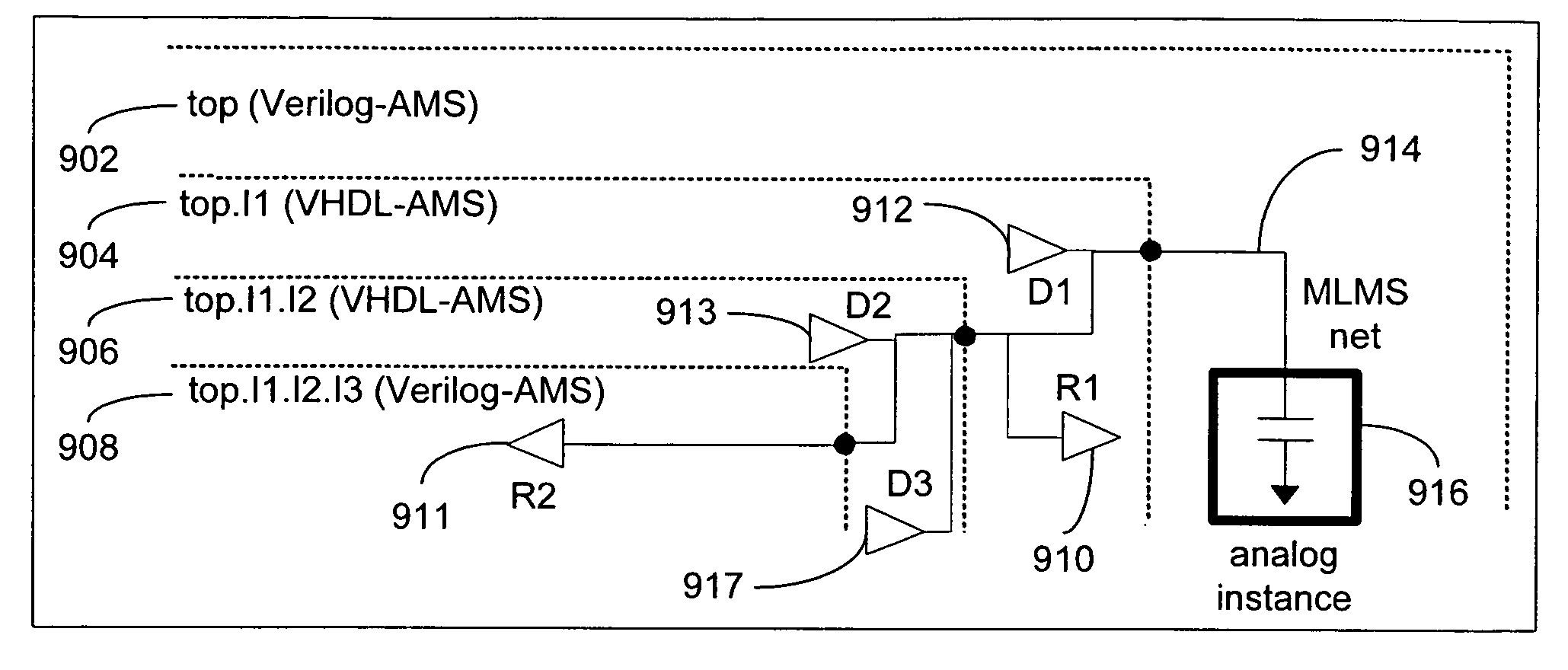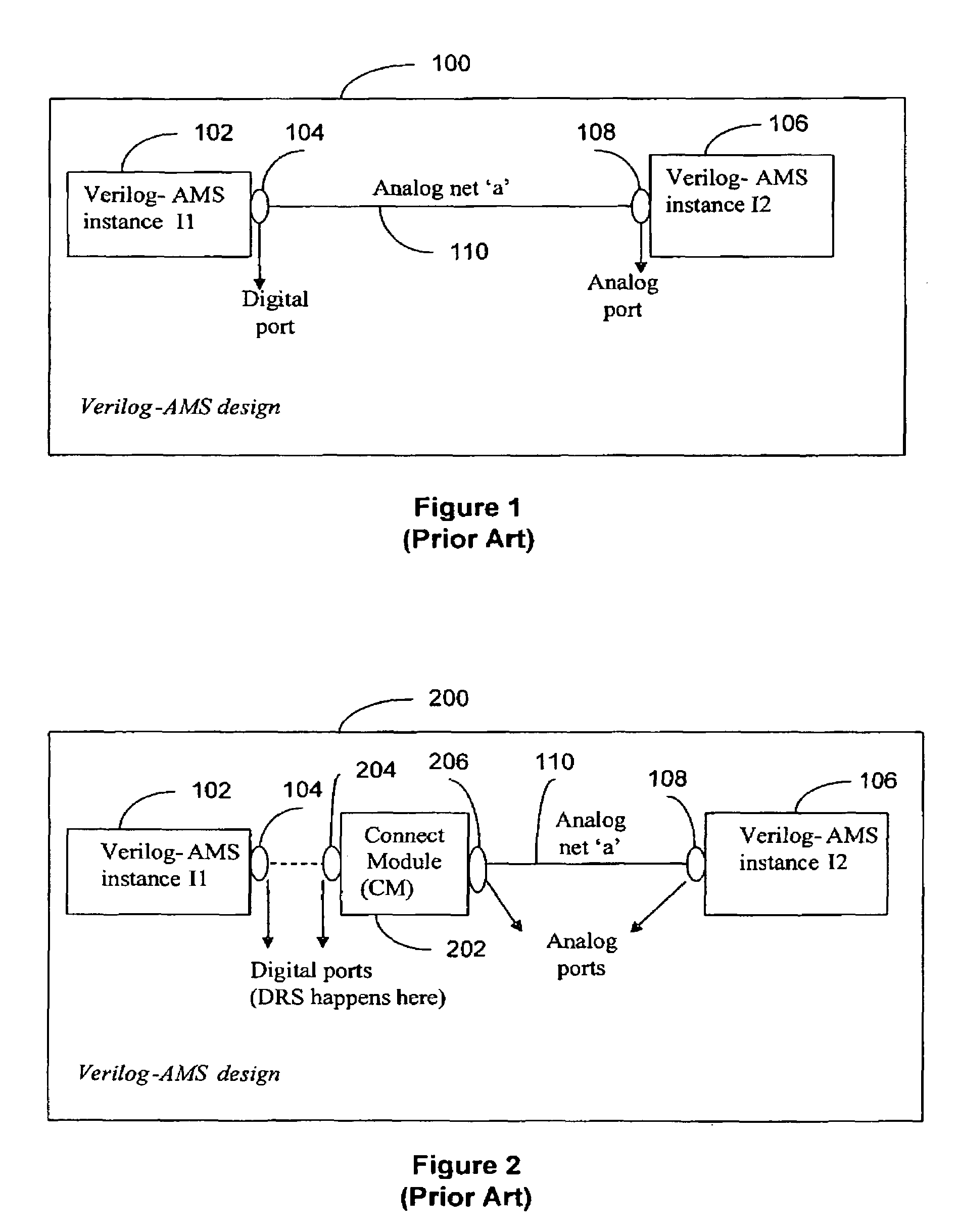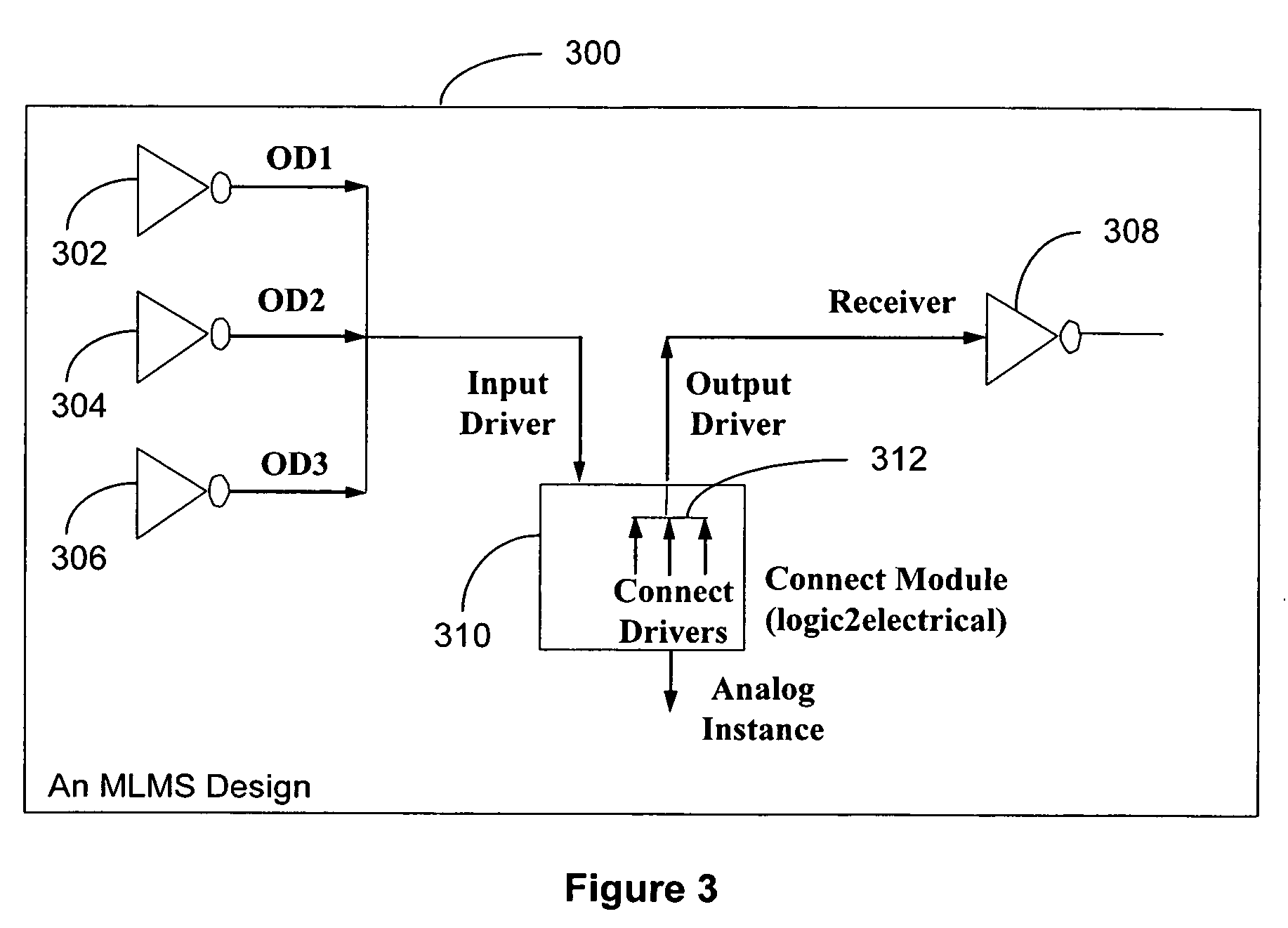Modeling a mixed-language mixed-signal design
a mixed-language mixed-signal and design technology, applied in the field of integrated circuit design and verification, can solve the problems of lack of compatibility between vhdl-ams and verilog-ams languages, lack of support for driver-receiver segregation (drs), and process of identification
- Summary
- Abstract
- Description
- Claims
- Application Information
AI Technical Summary
Benefits of technology
Problems solved by technology
Method used
Image
Examples
case 1
g-AMS Drivers with Verilog-AMS Receivers
[0052]FIG. 4a illustrates a hierarchical design having one or more Verilog-AMS drivers and Verilog-AMS receivers in an MLMS environment. This scenario is distinguished from a pure Verilog-AMS design. In this case, an MLMS net can pass through VHDL-AMS blocks that do not receive or drive any values on the MLMS net. The hierarchical design may include hierarchical levels from both Verilog-AMS and VHDL-AMS languages. In particular, the hierarchical design includes a top level (Verilog-AMS) 402, a first sub-level top.I1 (VHDL-AMS) 404, a second sub-level top.I1.I2 (VHDL-AMS), and a third sub-level top.I1.I2.I3 (Verilog-AMS). The top level 402 includes a first Verilog-AMS receiver (R1) 410 and the third sub-level top.I1.I2.I3408 includes a first Verilog-AMS driver (D1) 412. D1 drives R1 through an MLMS net 414, which crosses both the Verilog-AMS and VHDL-AMS language boundaries. An analog instance 416 is attached to the MLMS net at the top level 40...
case 2
g-AMS Drivers with VHDL-AMS Receivers
[0055]FIG. 5a illustrates a hierarchical design having one or more Verilog-AMS drivers and VHDL-AMS receivers in an MLMS environment. The hierarchical design includes hierarchical levels from both Verilog-AMS and VHDL-AMS languages. In particular, the hierarchical design includes a top level (Verilog-AMS) 502, a first sub-level top.I1 (VHDL-AMS) 504, a second sub-level top.I1.I2 (VHDL-AMS) 506, and a third sub-level top.I1.I2.I3 (Verilog-AMS) 508. The top level 502 includes a first Verilog-AMS driver (D1) 510, the second sub-level top.I1 includes a first VHDL-AMS receiver (R1) 512, and the third sub-level top.I1.I2.I3 includes a second Verilog-AMS driver (D2) 511. Both D1 and D2 drive R1 through an MLMS net 514, which crosses both the Verilog-AMS and VHDL-AMS language boundaries. An analog instance 516 is attached to the MLMS net at the top level 502.
[0056]FIG. 5b illustrates a method of performing DRS on the Verilog-AMS drivers and VHDL-AMS rece...
case 3
g-AMS Drivers with Verilog-AMS and VHDL-AMS Receivers
[0058]FIG. 6a illustrates a hierarchical design having one or more Verilog-AMS drivers and Verilog-AMS and VHDL-AMS receivers in an MLMS environment. The hierarchical design includes hierarchical levels from both Verilog-AMS and VHDL-AMS languages. In particular, the hierarchical design includes a top level (Verilog-AMS) 602, a first sub-level top.I1 (VHDL-AMS) 604, a second sub-level top.I1.I2 (VHDL-AMS) 606, and a third sub-level top.I1.I2.I3 (Verilog-AMS) 608. The top level 602 includes a first Verilog-AMS driver (D1) 610, the first sub-level top.I1 includes a first VHDL-AMS receiver (R1) 612, and the third sub-level top.I1.I2.I3 includes a second Verilog-AMS driver (D2) 611 and a second Verilog-AMS receiver (R2) 613. Both D1 and D2 drive R1 and R2 through an MLMS net 614, which crosses both the Verilog-AMS and VHDL-AMS language boundaries. An analog instance 616 is attached to the MLMS net at the top level 602.
[0059]FIG. 6b il...
PUM
 Login to View More
Login to View More Abstract
Description
Claims
Application Information
 Login to View More
Login to View More - R&D
- Intellectual Property
- Life Sciences
- Materials
- Tech Scout
- Unparalleled Data Quality
- Higher Quality Content
- 60% Fewer Hallucinations
Browse by: Latest US Patents, China's latest patents, Technical Efficacy Thesaurus, Application Domain, Technology Topic, Popular Technical Reports.
© 2025 PatSnap. All rights reserved.Legal|Privacy policy|Modern Slavery Act Transparency Statement|Sitemap|About US| Contact US: help@patsnap.com



